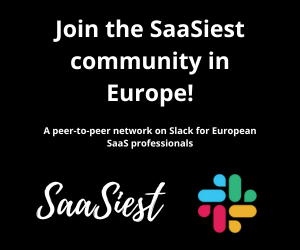Haresh Bajaj, VP of Product Growth at business spending management company Pleo, gave an insightful presentation at SaaSiest 2023 on how to leverage product-led growth (PLG) to unlock happier customers, move towards stronger net retention revenue (NRR), and achieve stronger unit economics with a path to profitability using Pleo as a case study of a winning formula.
Takeaways
- Product-led growth is becoming critical to meet customer expectations for self-service, enable efficient and scalable growth, and drive toward profitability.
- Companies should increase focus on existing customers, where it’s far easier to expand versus acquiring new customers. Prioritize customer success and NRR.
- Combine a bottom-up product-led approach with top-down sales and customer success by implementing PLG across the entire customer journey – acquisition, sales, onboarding, adoption, and expansion. Align cross-functional teams around shared goals.
- Investment into dedicated commercial operations, data, and basic transformation is critical.
- PLG can drive impressive results – higher conversion rates, faster onboarding, increased adoption, account expansion, and most importantly stronger unit economics.
- Pleo’s experience provides a proven formula for SaaS companies to adopt product-led motions, serving customers in a scalable and efficient way.
The evolving need for product-led growth
Three key trends are driving the need to adopt PLG:
- Customer expectations: 75% of B2B buyers now expect self-serve options versus traditional sales reps. PLG delivers the DIY experience users demand.
- Efficient growth: Many B2B SaaS companies share a common goal – the need to find more scalable ways to acquire customers and expand versus just adding sales reps. PLG enables viral, efficient growth.
- Profitability focus: In the current climate, unprofitable growth is unacceptable. PLG improves unit economics and the path to profitability.
In light of these trends, there are three necessary shifts we need to make:
- Increase focus on existing customers: It’s 6-7x more expensive to acquire new customers than grow existing ones. Companies need to prioritize customer success and deepen relationships, which will translate into better NRR.
- Adopt PLG company-wide: Rather than just top-of-funnel, enable self-service across the entire customer journey.
- Drive stronger unit economics: Lower CAC, reduce payback period, improve gross margins.
Implementing PLG: The product-led go-to-market infinity loop
Pleo implemented PLG across five key areas.
One of the most important things you need to do is to bring together the various functions and teams and make sure that they have the right single KPI that they’re responsible for.
Product-led acquisition
Growth marketing and web teams work jointly on lead gen with shared goals around the pipeline value of MQLs and CAC. At Pleo, they optimize self-serve signups by running 90 website experiments per quarter to increase website conversion rates.
Product-led sales
Sales reps focused on new business are aligned with product signup flows. Both groups are jointly responsible for helping potential customers assess whether the solution is right for them or not. Shared objectives relate to new ARR, win rates, and sales rep quotas.
Product-led onboarding and adoption
Customer success and product teams partner on timely onboarding and adoption of high-value features. Goals include reducing churn and accelerating onboarding velocity.
Product-led expansion
Account management and product growth teams expand usage. OKRs are based on ARR expansion, average revenue per account, and users per customer.
Critical enablers of PLG
To make PLG work, you need to invest in three critical enablers:
- Dedicated commercial operations: Orchestrate cross-functional go-to-market motions triggered by usage data and signals. Guide the right outreach to the right customer at the right time via the right channels.
- Data and analytics: Uncover signals that indicate churn risk, expansion potential, and buyer intent. Invest in basic data science to build data models and statistical analyses to correlate product usage with business outcomes like NRR and identify drivers of success.
- Basic transformation: With PLG, Pleo has realized transformative results, including a 100% increase in pipeline efficiency, 20% cost per deal, 50% higher win rates, 50% growth in average deal size, 20% faster time-to-onboard new customers, 10-30% more adoption of key features, 40% more users per customer, 10% growth in average revenue per user, and a 2% churn rate.
A proven formula
Pleo’s approach represents a proven formula for any SaaS company looking to adopt a product-led motion in a customer-centric, profitable manner. The right structure, incentives, and team combined with investment into commercial operations, data, and basic transformation will give your company the best chance of success.
To watch Haresh’s presentation, please visit SaaSiest TV.




